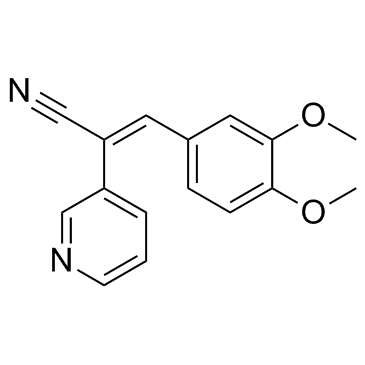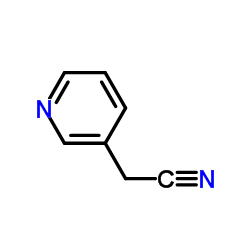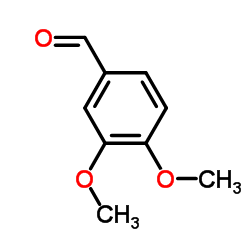RG-13022

RG-13022 structure
|
Common Name | RG-13022 | ||
|---|---|---|---|---|
| CAS Number | 136831-48-6 | Molecular Weight | 266.29500 | |
| Density | 1.172g/cm3 | Boiling Point | 423.8ºC at 760mmHg | |
| Molecular Formula | C16H14N2O2 | Melting Point | 118 °C | |
| MSDS | Chinese USA | Flash Point | 210.1ºC | |
Use of RG-13022RG13022 is a tyrosine kinase inhibitor; inhibits the autophosphorylation reaction of the EGF receptor with an IC50 of 4 μM. |
| Name | tyrphostin rg 13022 |
|---|---|
| Synonym | More Synonyms |
| Description | RG13022 is a tyrosine kinase inhibitor; inhibits the autophosphorylation reaction of the EGF receptor with an IC50 of 4 μM. |
|---|---|
| Related Catalog | |
| Target |
IC50: 4 μM (EGF receptor autophosphorylation)[1] |
| In Vitro | RG13022 suppresses EGF-stimulated cancer cell proliferation. In a cell-free reaction RG13022 inhibits the autophosphorylation reaction of the EGF receptor in immunoprecipitates with an IC50 of 4 μM. RG13022 inhibits colony formation and DNA synthesis by HER 14 cells, which were stimulated by 50 ng/mL EGF, in a dose-dependent manner. The IC50s are 1 and 3 μM for HER 14 colony formation and DNA synthesis, respectively[1]. RG-13022 inhibits not only EGF-induced growth but also growth stimulated by insulin, insulin-like growth factor I, insulin-like growth factor II, or transforming growth factor alpha. RG-13022 also totally blocks estrogen-stimulated phosphorylation of the EGF receptor, as well as estrogen-induced cell proliferation, suggesting that functioning TK pathways are required for estrogen action[2]. |
| In Vivo | RG13022 suppresses tumor growth in nude mice. RG13022 also increases the life span of these tumor-bearing nude mice[1]. |
| Cell Assay | 40 mM stock solutions of RG13022 is made in 100% DMSO and diluted with the culture medium before addition to the cells. MH-85 cells and HER 14 cells are plated in culture medium in the presence or absence of increasing concentrations of RG-13022 or RG-14620 for 10 days. At the end of culture, the cells are fixed with 4% (v/v) formaldehyde and stained with hematoxylin. Numbers of colonies including more than 20 cells in each well are counted under the microscope[1]. |
| Animal Admin | Mice: MH-85 tumors 5 mm in diameter are inoculated s.c. into the right dorsal portion of 4- to 6-week-old male BALB/c nu/nu mice. RG-13022 or RG-14620 in 0.1 ml 100% DMSO is injected i.p. twice a day from 1day after MH-85 tumor inoculation. Control animals are given the same vehicle. Tumor sizes are measured once a week under anesthesia with nembutal (0.05 mg/g body weight, i.p.) and calculated[1]. |
| References |
| Density | 1.172g/cm3 |
|---|---|
| Boiling Point | 423.8ºC at 760mmHg |
| Melting Point | 118 °C |
| Molecular Formula | C16H14N2O2 |
| Molecular Weight | 266.29500 |
| Flash Point | 210.1ºC |
| Exact Mass | 266.10600 |
| PSA | 55.14000 |
| LogP | 3.16298 |
| Vapour Pressure | 2.18E-07mmHg at 25°C |
| Index of Refraction | 1.605 |
| Personal Protective Equipment | Eyeshields;Gloves;type N95 (US);type P1 (EN143) respirator filter |
|---|---|
| Safety Phrases | S22-S24/25 |
| RIDADR | NONH for all modes of transport |
| Precursor 2 | |
|---|---|
| DownStream 0 | |
|
The antiproliferative effects of tyrosine kinase inhibitors tyrphostins on a human squamous cell carcinoma in vitro and in nude mice.
Cancer Res. 51 , 4430, (1991) Many human tumors of epithelial origin contain cells overexpressing the epidermal growth factor (EGF) receptor, and there is convincing evidence that cancer cell growth is correlated with the loss of ... |
|
|
Intrapituitary regulatory system of mammotrophs in the mouse.
Arch. Physiol. Biochem. 110(1-2) , 34-41, (2002) Estrogen stimulates the proliferation of pituitary cells, in particular mammotrophs. The present study was designed to clarify involvement of transforming growth factor alpha (TGF-alpha) in the estrog... |
|
|
Inhibition of breast cancer cell growth in vitro by a tyrosine kinase inhibitor.
Cancer Res. 52(13) , 3636-41, (1992) Human breast cancer cell proliferation is regulated by growth factors that bind to receptors with intrinsic tyrosine kinase (TK) activity, including the epidermal growth factor (EGF) receptor. To dete... |
| 2-(3,4'-Dimethoxyphenyl)-1-(3''-pyridinyl)acrylonitrile |
| MFCD00236444 |
| RG-13022 |

